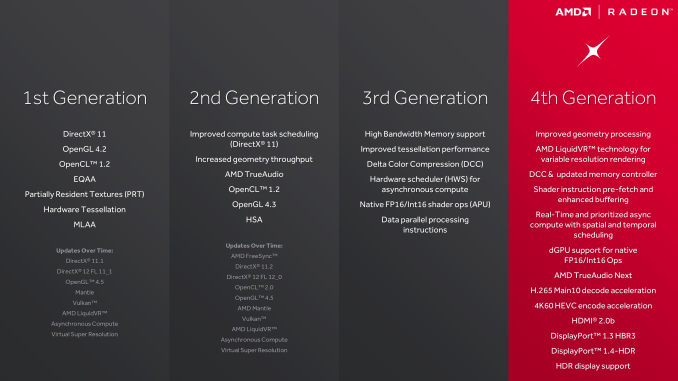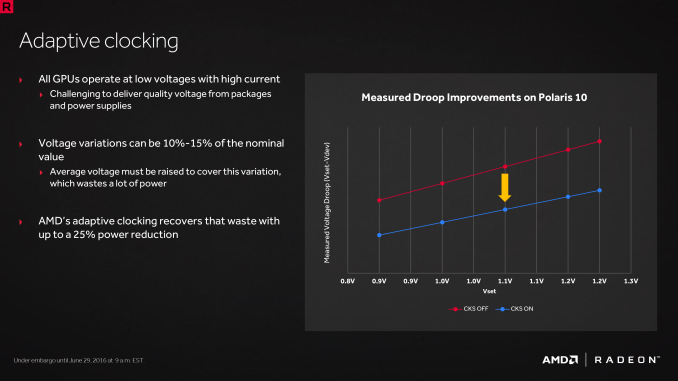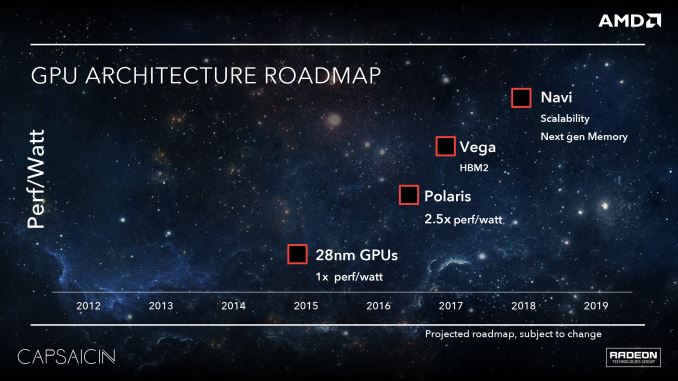The AMD Radeon RX 480 Preview: Polaris Makes Its Mainstream Mark
by Ryan Smith on June 29, 2016 9:00 AM ESTAMD's Path to Polaris
With the benefit of hindsight, I think in reflection that the 28nm generation started out better for AMD than it ended. The first Graphics Core Next card, Radeon HD 7970, had the advantage of launching more than a quarter before NVIDIA’s competing Kepler cards. And while AMD trailed in power efficiency from the start, at least for a time there they could compete for the top spot in the market with products such as the Radeon HD 7970 GHz Edition, before NVIDIA rolled out their largest Kepler GPUs.
However I think where things really went off of the rails for AMD was mid-cycle, in 2014, when NVIDIA unveiled the Maxwell architecture. Kepler was good, but Maxwell was great; NVIDIA further improved their architectural and energy efficiency (at times immensely so), and this put AMD on the back foot for the rest of the generation. AMD had performant parts from the bottom R7 360 right up to the top Fury X, but they were never in a position to catch Maxwell’s efficiency, a quality that proved to resonate with both reviewers and gamers.
The lessons of the 28nm generation were not lost on AMD. Graphics Core Next was a solid architecture and opened the door to AMD in a number of ways, but the Radeon brand does not exist in a vacuum, and it needs to compete with the more successful NVIDIA. At the same time AMD is nothing if not scrappy, and they can surprise us when we least expect it. But sometimes the only way to learn is the hard way, and for AMD I think the latter half of the 28nm generation was for the Radeon Technologies Group learning the hard way.
So what lessons did AMD learn for Polaris? First and foremost, power efficiency matters. It matters quite a lot in fact. Every vendor – be it AMD, Intel, or NVIDIA – will play up their strongest attributes. But power efficiency caught on with consumers, more so than any other “feature” in the 28nm generation. Though its importance in the desktop market is forum argument fodder to this day, power efficiency and overall performance are two sides of the same coin. There are practical limits for how much power can be dissipated in different card form factors, so the greater the efficiency, the greater the performance at a specific form factor. This aspect is even more important in the notebook space, where GPUs are at the mercy of limited cooling and there is a hard ceiling on heat dissipation.
As a result a significant amount of the work that has gone into Polaris has been into improving power efficiency. To be blunt, AMD has to be able to better compete with NVIDIA here, but AMD’s position is more nuanced than simply beating NVIDIA. AMD largely missed the boat on notebooks in the last generation, and they don’t want to repeat their mistakes. At the same time, starting now with an energy efficient architecture means that when they scale up and scale out with bigger and faster chips, they have a solid base to work from, and ultimately, more chances to achieve better performance.
The other lesson AMD learned for Polaris is that market share matters. This is not an end-user problem – AMD’s market share doesn’t change the performance or value of their cards – but we can’t talk about what led to Polaris without addressing it. AMD’s share of the consumer GPU market is about as low as it ever has been; this translates not only into weaker sales, but it undermines AMD’s position as a whole. Consumers are more likely to buy what’s safe, and OEMs aren’t much different, never mind the psychological aspects of the bandwagon effect.
Consequently, with Polaris AMD made the decision to start with the mainstream market and then work up from there, a significant departure from the traditional top-down GPU rollouts. This means developing chips like Polaris 10 and 11 first, targeting mainstream desktops and laptops, and letting the larger enthusiast class GPUs follow. The potential payoff for AMD here is that this is the opposite of what NVIDIA has done, and that means AMD gets to go after the high volume mainstream market first while NVIDIA builds down. Should everything go according to plan, then this gives AMD the opportunity to grow out their market share, and ultimately shore up their business.
As we dive into Polaris, its abilities, and its performance, it’s these two lessons we’ll see crop up time and time again, as these were some of the guiding lessons in Polaris’s design. AMD has taken the lessons of the 28nm generation to heart and have crafted a plan to move forward with the FinFET generation, charting a different, and hopefully more successful path.
Though with this talk of energy efficiency and mainstream GPUs, let’s be clear here: this isn’t AMD’s small die strategy reborn. AMD has already announced their Vega architecture, which will follow up on the work done by Polaris. Though not explicitly stated by AMD, it has been strongly hinted at that these are the higher performance chips that in past generations we’d see AMD launch with first, offering performance features such as HBM2. AMD will have to live with the fact that for the near future they have no shot at the performance crown – and the halo effect that comes with it – but with any luck, it will put AMD in a better position to strike at the high-end market once Vega’s time does come.













449 Comments
View All Comments
ffleader1 - Thursday, June 30, 2016 - link
Can you maybe redo the test with updated driver.It seems that newer driver really makes a HUGE difference.
https://www.reddit.com/r/Amd/comments/4qiffg/rx_48...
Ryan Smith - Friday, July 1, 2016 - link
This was done with the latest driver to begin with: 16.6.2. The press was not distributed any other driver AFAIK.Falko83 - Thursday, June 30, 2016 - link
I hope that in the review you can also address 1080p 144hz gaming.davide445 - Thursday, June 30, 2016 - link
"Relative to last-generation mainstream cards like the GTX 960 or the Radeon R9 380, with the Radeon RX 480 we’re looking at performance gains anywhere between 45% and 70%, depending on the card, the games, and the memory configuration. As the mainstream market was last refreshed less than 18 months ago, the RX 480 generally isn’t enough to justify an upgrade"This is something I didn't understand. 45-70% performance increase it's not enough for a card that request less power and cost less?
Also where is the problem with the fact the power consumption is above equivalent Nvidia? At 150w I doubt anyone upgrading need a new PSU. I suppose below a threshold power request it's not part of the game anymore, otherwise next request will be that a GPU will produce power and not need some....
dragonsqrrl - Thursday, June 30, 2016 - link
Ryan addressed some of this in response to an earlier comment:"Although it's not an objective metric, generally I'm looking for an average 65%+ performance increase to justify replacing a video card. Against 380 in particular, 480 doesn't quite reach that mark."
150W TDP wouldn't be a problem in a vacuum, but unfortunately AMD is competing against Nvidia, not just at the midrange, but the whole product stack including the high-end. That means AMD is going to have more trouble scaling performance this coming generation, not unlike the last. In modern microarchitectures performance and efficiency are basically the same thing because we've hit the TDP ceiling for these form factors. I think Ryan actually explained it quite elegantly:
"power efficiency and overall performance are two sides of the same coin. There are practical limits for how much power can be dissipated in different card form factors, so the greater the efficiency, the greater the performance at a specific form factor. This aspect is even more important in the notebook space, where GPUs are at the mercy of limited cooling and there is a hard ceiling on heat dissipation."
davide445 - Thursday, June 30, 2016 - link
Maybe I'm asking too much objectivity. Asking for +65% for performance increase is nothing without a specific reason. 960 vs 760 show a 6% increase in 3dmark performances.760 vs 660 show a 20% increase. 660 vs 560 show a 55% increase (data from GPU boss). So why a 40-70% (average 55%) is not enough? It's the same you can achieve with two generations of Nvidia equivalent.About TDP ok for competing, but what I'm saying is it's not more relevant. Ok when AMD GPU was 200-250w hungry and Nvidia equivalent was 100w less, but with 150w really make difference for anyone for maybe 50w? Also didn't understand about the whole stack competition, we need to compare same price level: 480 vs 380 or 390 or 960 or 970, 1070 is available on Newegg for $430 min, 1060 is not available at all.
dragonsqrrl - Thursday, June 30, 2016 - link
It sounds like you're under the impression he recommended upgrading from a 760 to a 960, he did not."Also didn't understand about the whole stack competition"
Then am I correct in assuming you don't understand the significance of TDP ceilings for a given form factor? If you have a less efficient architecture, you're going to have a less performant GPU once you approach that ceiling. It's not as concrete for desktop discrete GPUs as it is for notebooks, but there are still upper limits, which tend to be around 250-300W. AMD can always price competitively, but the last thing they need right now is a repeat of last gen. They need competitive 'products' in their lineup, and for AMD, in terms of financial and competitive viability, that means a lot more than just price/performance ratios. This has less to do with the RX480 right now and more to do with prospects for the rest of the generation.
Ananke - Thursday, June 30, 2016 - link
Let me simplify for you: The question is "What can I get for $200?". RX480, RX380, GT960, GT950.Very simple choice at the moment.
dragonsqrrl - Thursday, June 30, 2016 - link
@AnankeYes, yes it is. But if you read the last sentence in my previous comment, and the rest of my responses the the thread, you'd hopefully realize that's besides the point.
davide445 - Thursday, June 30, 2016 - link
I suppose depends what these reviews are expected for. IMHO (and of course this is my personal opinion) these need to be guides useful for informed purchase, similar to what you did expect from stock investment advice. So you need to be specific about your assumptions and audience.These cards are not for mobile, so mobile is not in the equation. We are discussing about a specific card, not a corporate or tech startegy. We are discussing about mostly gaming or DX performances, so the audience are using a PC and didn't consider enough integrated GPU. So need to decide mostly if upgrade, not to purchase the first one considering how PC market is going. So the decision this review need to address is what GPU on the market this people need to purchase, considering a target price and average PC specs.